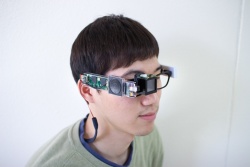K-Glass
| K-Glass | |
|---|---|

|
|
| Category | smartglasses |
| Developer | Korea Advanced Institute of Science and Technology [1] |
| Announced | 17 February 2014 [2] |
| Released | Developers: 2014
Consumers: 2015 [3] |
| Price | USD (unknown) |
| Operating system | Android [4] |
| Display | LCD [4] |
| Resolution | 800x600 pixels [4] |
| Field of view | (unknown) |
| Weight | g (unknown) |
| Controls | |
| Data available | good |
| Risk factor | low |
| Standalone | |
| http://ssl.kaist.ac.kr/ | |
K-Glass is a head-mounted, augmented reality system being developed by Korea Advanced Institute of Science and Technology (KAIST). It uses novelty image recognition hardware and software to quickly analyse the scene through the incorporated camera and displays relevant information to the user.
The device has not yet entered commercial market. Professor Yoo Hoi-jun[6], one of the authors of the paper introducing the device, said that they planned to commercialize the device by the beginning of 2015.[3] As of December 2015, no new information is known about K-Glass, nor is the device available to purchase.
There is a new iteration of the device called K-Glass 2, see below for more information.
Contents
Main characteristics
The device consists of one 800x600 pixels micro-display, 720p camera, touchpad, and auxiliary hardware. K-Glass uses novel way of image recognition. The on-board augmented reality processor BONE-AR utilizes data processing network to analyse the scene and allows the device to react with relevant virtual information quickly. This custom processor is based on the Visual Attention Model that mimics how natural human vision works, without the need to use any markers.[7] In comparison to similar HMD systems, K-Glass recognizes items in the scene quicker and uses less power.[4]
KAIS also developed a newer version called K-Glass 2.[8][9] This iteration is equipped with gaze recognition interface called i-Mouse. It enables the user to use gaze and winking as a form of input. KAIST uploaded a video demonstration of K-Glass 2 image recognition abilities to Youtube.[10]
Purpose
K-Glass aims to offer head-mounted system capable of fast image recognition that uses less power and can utilize user's gaze and winking as input.
Company & People
Korea Advanced Institute of Science and Technology (KAIST) is a public research university located in Daedeok Innopolis, Daejeon, South Korea.[1] K-Glass is developed by the Semiconductor System Laboratory (SSL) under the Department of Electrical Engineering.[11]
- Gyeonghoon Kim - Post Doctorate Researcher[12]
- Sungpill Choi - Professor ( Ph.D.)[13]
- Hoi-Jun Yoo - Ph.D. Student[6]
Important Dates
17 February 2014 - SSL publishes a paper detailing K-Glass[2] 23 February 2015 - Introduction of the improved K-Glass 2[14]
Enhancement/Therapy/Treatment
Ethical & Health Issues
Public & Media Impact and Presentation
Public Policy
Related Technologies, Projects or Scientific Research
International Solid-State Circuits Conference (ISSCC), February 9-13, 2014, San Francisco[15]
Links
https://www.youtube.com/watch?v=fzQpSORKYr
http://phys.org/news/2015-03-kaist-ui-k-glass-eye.html
http://phys.org/news/2014-02-low-powered-high-speed-head-mounted-augment-reality.html
http://www.itweb.co.za/index.php?option=com_content&view=article&id=142116
http://www.koreaherald.com/view.php?ud=20140702000859
http://www.gizmag.com/k-glass-smart-glass/30904/
http://www.sciencedaily.com/releases/2014/02/140217084420.htm
References
- ↑ 1.0 1.1 Korea Advanced Institute of Science and Technology [online]. Available online at: http://www.kaist.edu/html/en/ (Retrieved 15 December)
- ↑ 2.0 2.1 KAIST developed an extremely low-powered, high-performance head-mounted display embedding an augmented reality chip. Research: asia research news [online]. 2014, 17 February. Available online at: http://www.researchsea.com/html/article.php/aid/8078/cid/1/research/science/researchsea/kaist_developed_an_extremely_low-powered__high-performance_head-mounted_display_embedding_an_augmented_reality_chip.html (Retrieved 15 December 2015)
- ↑ 3.0 3.1 JI-HYE, Shin. K-Glass to be unveiled in 2015. The Korea Herald [online]. 2014, 2 July. Available online from: http://www.koreaherald.com/view.php?ud=20140702000859 (Retrieved 15 December 2015)
- ↑ 4.0 4.1 4.2 4.3 4.4 KIM, Gyeonghoon; CHOI, Sungpill; YOO, Hoi-Jun. K-glass: Real-time markerless augmented reality smart glasses platform. In: Industrial Technology (ICIT), 2015 IEEE International Conference on. IEEE, 2015. p. 1712-1717.
- ↑ RAWLINS, Lauren Kate. Smart glasses that work with a wink. ITWeb Limited [online]. Johannesburg, 2015, 24 March. Dostupné z: http://www.itweb.co.za/index.php?option=com_content (Retrieved 15 December)
- ↑ 6.0 6.1 http://ssl.kaist.ac.kr/2007/sub3_1.php
- ↑ http://phys.org/news/2014-02-low-powered-high-speed-head-mounted-augment-reality.html
- ↑ https://www.ee.kaist.ac.kr/eng/article.do?tableid=esub07_08_01&menu_code=030203&page_num=&id=5468
- ↑ http://phys.org/news/2015-03-kaist-ui-k-glass-eye.html
- ↑ KASIPR. K-Glass 2 with i-Mouse (UI). 11 March 2015. Available online at: https://www.youtube.com/watch?v=JaYtYK9E7p0 (Retrieved 15 December 2015)
- ↑ https://www.ee.kaist.ac.kr/eng/main.do
- ↑ http://ssl.kaist.ac.kr/2007/sub3_3_24.php
- ↑ http://ssl.kaist.ac.kr/2007/sub3_3_38.php
- ↑ http://phys.org/news/2015-03-kaist-ui-k-glass-eye.html
- ↑ KIM, Gyeonghoon, et al. A 1.22 TOPS and 1.52 mW/MHz Augmented Reality Multicore Processor With Neural Network NoC for HMD Applications. Solid-State Circuits, IEEE Journal of, 2015, 50.1: 113-124.